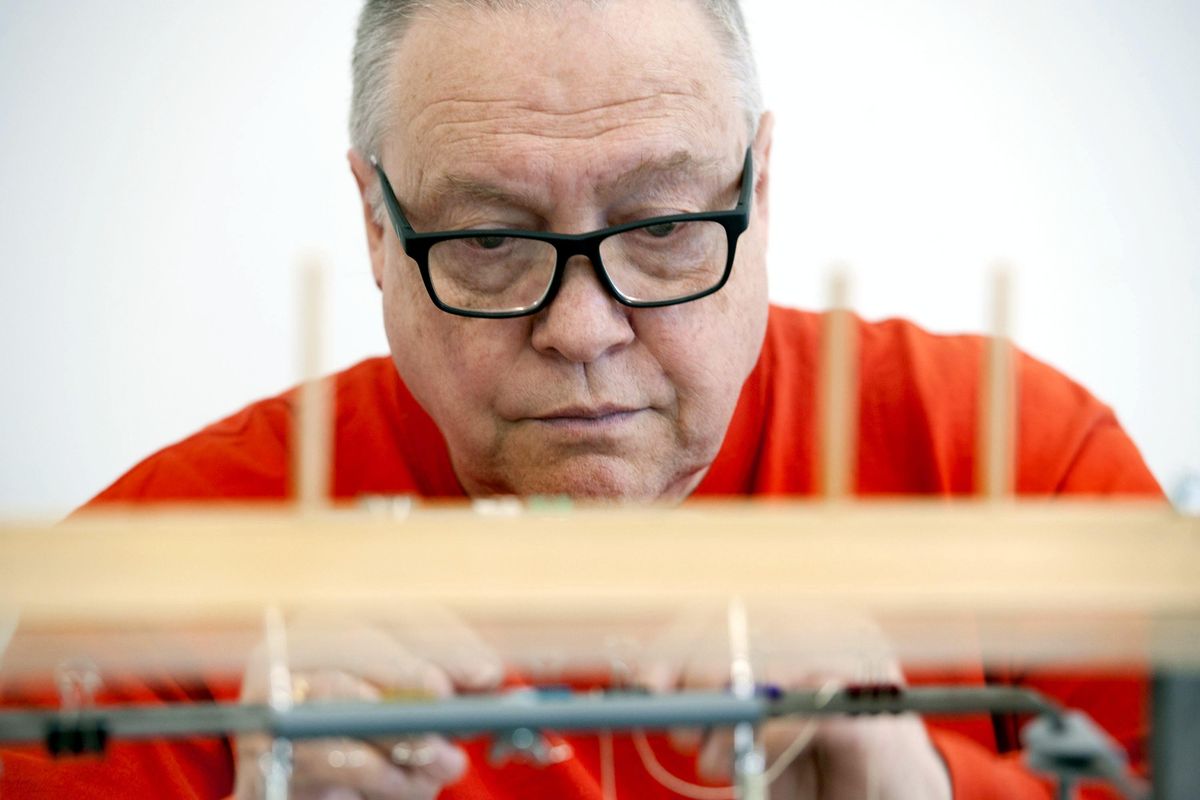North Spokane Library’s October creator-in-residence demonstrates ancient craft of bookmaking

Before Johannes Gutenberg ushered in the printing revolution in the 15th century, books were made by hand. Written on clay, papyrus, wax and parchment, the manuscripts were available only to clergymen or the very wealthy.
Last week in a glass-walled room in a building filled with books of every shape, size and subject matter, available to anyone with a library card, Timothy Ely demonstrated this ancient craft.
Using linen cord that a century ago was used to make fishing nets, he carefully sewed a raised cord binding on a book made of French paper.
Ely is October’s creator-in-residence at the North Spokane Library.
“Every piece of technology has a dark side,” he said. “When the printing press happened, suddenly 50 books at a time could be made and we lost the art, the skill and the craft of making a manuscript book.”
Thankfully, the skill wasn’t completely lost. Ely and a few others still create manuscript books.
“Most of the binders I know work in conservation or repair,” he said. “And there aren’t very many of us.”
He rarely does that kind of work, instead focusing on creating unique hand-crafted books – books you won’t usually find on Amazon.
Ely has several examples of his work at the library, including “Embryo,” a model of a gold-embossed, leather bound volume he created for the Lilly Library at Indiana University in Bloomington, Indiana.
“They collect all sorts of amazing things. There’s thousands and thousands of manuscript books in their library,” Ely said. “I make a book for them every year.”
This is the second year of the creator-in-residence program at the North Spokane Library. Artists, gardeners, crafters and others demonstrate their skills in the glass-walled lab and conduct at least two workshops. Library visitors are encouraged to stop in the lab and watch and learn.
“There’s something so fascinating about watching people make stuff and being able to ask them questions while they do it,” said Gwendolyn Haley, Spokane County Library District manager of education and enrichment services.
In November, a jewelry designer will be the creator-in residence, followed by a cake decorator in December.
Hosting a book maker in a library seems like a perfect fit.
“We handle books every day, and we don’t really know what goes into them,” Haley said.
Ely is happy to demonstrate.
“The library is a potent physical funnel for me,” he said. “It’s a fulcrum of information.”
Usually, he works in solitude in his studio at his Colfax, Washington, home.
Drawing is his first love. Holding up a tiny book, he said, “This small book took me more than a month to draw. I love the extremity of anti-speed.”
You won’t find traditional chapters or densely packed words in his books.
“I don’t write in English or in a language, but it looks linguistic,” said Ely. “I make things that are meant to be looked at.”
Symbols, numbers and graphs fill the pages. Architectural renderings, watercolors and pigments made from Mongolian dirt and Balkan sand find their way between the covers.
“I make things I want to see that don’t exist in the world – that’s the enjoyment,” he said.
Ely was a design major in school and bought his first book binding manual for $1.75 at the University of Washington bookstore.
In 1975, a week out of graduate school, he made his first book. Though he worked as a musician for a time, he didn’t like the hours and decided to focus on making books. Dealers in New York and Maine handle his work, and he never runs out of ideas.
Currently he’s working on a manuscript with a sound artist.
“I’ve composed six pieces of music that he will play, and a CD will be included with the book,” he said.
The creators spend 16 hours in the library during their residency. Ely is there from 10 a.m. to 2 p.m. on Wednesdays in October.
“The program is sponsored by the Friends of the North Spokane Library,” Haley said. “When you buy books at their book sales, you’re sponsoring this,”
As Ely painstakingly wound the linen thread on his sewing frame, he reflected on how close this craft came to being lost forever.
“I don’t think things really die,” he said. “But they can be so easily forgotten.”